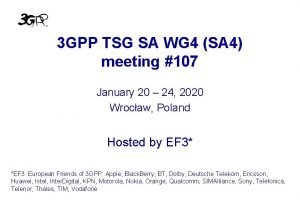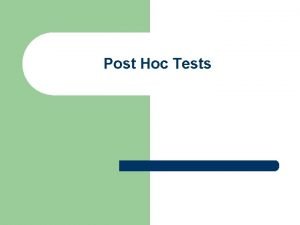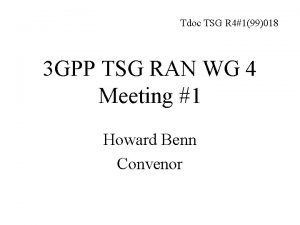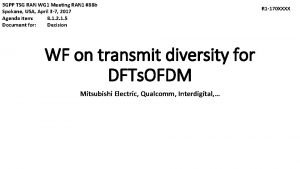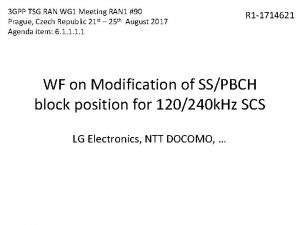3 GPP TSG RAN WG 1 Ad Hoc





- Slides: 5

3 GPP TSG RAN WG 1 Ad Hoc Meeting Qingdao, China, 27 -30 June 2017 R 1 -1711894 Agenda Item: 5. 1. 2. 4. 4 WF on Remaining Issues on PTRS for CP-OFDM Part I Huawei, Hi. Silicon, Inter. Digital, Xinwei, National Instruments, Panasonic

Background • For SU-MIMO, support predefined and RRC-configured association between PTRS densities and scheduled MCS/BW – FFS: RRC configuration can override the predefined association – Table 1 in R 1 -1709521 to represent association between PTRS time density and scheduled MCS – Table 2 in R 1 -1709521 to represent association between PTRS frequency density and scheduled BW – Note: The number of rows in Table 1 and 2 can be reduced if the densities are down-selected – FFS: UE to suggest MCS/BW thresholds in Table 1 and 2 – FFS: complementary DCI signaling • For CP-OFDM and the tables on next page, the time-densities (TD) of PTRS include every 4 th symbol, every 2 nd symbol, and every symbol, while the frequency-densities (FD) of PTRS include occupying one subcarrier (not necessarily in all REs, depending on the time density) in [every RB], every 2 nd RB, every 4 th RB, [every 8 th RB, and every 16 th RB] – The time density of PTRS is expected to increase with increasing the scheduled MCS (except for those reserved MCSs). – The frequency density of PTRS is expected to decrease with increasing the scheduled BW (i. e. , the number of scheduled RBs) • FFS: frequency localized mapping – FFS: The frequency density of PTRS is expected to increase with increasing the scheduled MCS 2

Background • Study the benefits of configuring the number of PTRS ports for a UE, based on UE capability or UE report on – Panels/TXRUs sharing a common oscillator or not, and/or – Maximum number of independent oscillators at this UE, and/or – Whether phase errors measured on PTRS ports are same or different 3

Background • Modulation and TBS index tables in 36. 211 – Some TBS index are reserved for some MCS index 4

Proposal • For PTRS for CP-OFDM, NR supports – Presence/time-density of PTRS for MCS index corresponding to reserved TBS index (if supported), is the same as the maximum MCS index associated with non-reserved TBS index but with the same modulation order – UE to report at least one the following information to facilitate PTRS configuration • UE panels/TXRUs sharing a common oscillator or not • Maximum number of independent oscillators at this UE • Phase errors measured on PTRS ports are same or different 5



